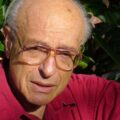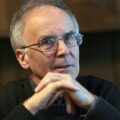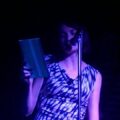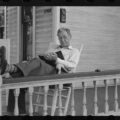A Graceful Way of Breathing: Remembering Anselm Hollo

Anselm Hollo, Josephine Clare, Custer the dog and Rudiethe cat helped me get born yesterday…
Tomaz Salamun, “September 20, 1972”
In the fall of 1973, my third year of college, I took a poetry-writing class from a gentle, encouraging professor named James Crenner, who’d published one book of poetry and, with Ira Sadoff, had started The Seneca Review, for which he still served as Editor. The class was small, friendly, and informal. We sat in a circle and discussed each other’s fledgling verses and the poems the professor brought to class. Our texts consisted of a thick, poorly-stapled stack of mimeographed poems—I remember the blue ink, and the smell—as well as the Selected Poems of Neruda and Vallejo, translated by Robert Bly, James Wright and John Knoepfle, one of the defining books of that period and certainly one of the most influential on the course of my own life. There may have been other texts, too; I don’t remember now.
I liked the poems Crenner showed us, mostly by the Confessionals and the “Deep Image” poets. It was a safe, mildly-challenging, enjoyable experience—until Crenner recited a translation of Cesar Vallejo’s “Black Stone Lying on a White Stone.” Something in that dark and fierce poem connected with a deep, inarticulate part of myself. Here, suddenly, wasa means of expression that made “sense” precisely because it didn’t—or didn’t quite—do so, a world in which emotions lit the way to a place I felt as though I knew intimately but hadn’t yet explored. I decided right then that I wanted to learn—to really learn—the art of poetry.
At that time, my most intense friendships were with aspiring jazz musicians who practiced for hours every day and listened with alert attention to every decent musician they came across. They thought and argued seriously about art, all kinds of music, film and the avant-garde. They were modest and supportive of each other, and they were summarily dismissive of anything they deemed lazy, sentimental or derivative. I adopted their intense, craftsman-like attitude. I read every poet I came across, copying lines in my notebook, imitating poems I liked, taking long walks, listening and starting to find some quivering whisper that might someday form the rudiments of true song. At the end of that year I approached Crenner and asked if he thought I could do a Senior Honors Project with Anselm Hollo, the Finnish poet and translator who now lived in the United States and who would be visiting Hobart as writer in residence during the coming academic year. Crenner gave me some paperwork to fill out.
Anselm was then in his early forties and just becoming an international presence in the cosmopolitan world of avant-garde writing. A widely published translator from Finnish, Russian, French and, other languages, his Red Cats—translations of Yevtushenko and Voznesensky—had been published 1967 by Ferlinghetti’s City Lights, #16 in its series of “pocket poets” books. It was the same year Anselm relocated to the US, where he would reside for the rest of his life.
Friends with Ginsberg and Creeley as well as many European writers whose names I hadn’t heard yet, Anselm himself was a vivid presence, with his bangs and shaggy, shoulder-length hair, his goatee, and his piercing blue eyes that seemed always to be looking simultaneously at me and at some object behind me. In his long black leather coat, scarf, and beret he looked sophisticated, urbane, European. His voice was deep, his accent pronounced, and his manners formal—but he was friendly and approachable at the same time, gentle and encouraging, never falsely enthusiastic. His courtliness masked a certain shyness, I think, and his whole demeanor—indeed the demeanor of his work itself—was infused with a kind of honesty that went deeper than mere truth telling. At the core of his work was a scintillating effervesce, a delight at the frustrations and foibles of contemporary life. He never seemed to take himself so seriously that he couldn’t see the irony or vanities in his own behavior, and he had one of the biggest, wildest laughs I had ever heard.
At one of our first meetings, a student came in and griped that he “hated” poetry. Anselm guffawed, glanced at me and told the kid he’d better watch out as “Michael and I are poets!” I was shocked—honored and embarrassed at the same time. I wasn’t ready to call myself “poet” yet, at least not out loud, and certainly not by such a figure as Anselm Hollo. Was Anselm saying that wanting to be a poet was sufficient to earn one that honorific? And if the desire to be equaled the fact of being, didn’t I have to cast off my jazz friends’ rigorous system of artistic value and embrace my very yearning as evidence of who I was? Such was Anselm’s generosity. Kindness, gentleness, delicacy, and a certain modest perspicacity defined his approach to others—and to the world at large. Already he was mentoring me.
Anselm had rented a trim two-story house a dozen blocks from campus—a five-minute bike ride—with his then-wife, the German poet Josephine Clare, who was also teaching at Hobart/William Smith that year. Their children were younger than I was; I don’t think I was ever formally introduced to them. A few times a week I’d put fresh poems in Anselm’s mailbox on campus, and at least once a week I’d ride or walk over to his house at a prearranged time—usually late morning—to talk. We’d sit in his living room, whose walls were covered with tacked-up posters advertising readings by poets—Philip Whalen, Ted Berrigan, Joanne Kyger, Alice Notley—whose work I had yet to read.
Anselm would offer coffee—strong and black and served in a demitasse cup—unfold my new jottings and point out what he liked. He would suggest words to cut, phrases to rearrange. His touch was light. He emphasized precision of detail and cadence, and he valued brevity. He encouraged me to strive for a kind of self-effacing humor and to trust the actuality of the real world.
Then, gazing at me but also out the window behind me, he’d talk about poets he thought I should read, and why. The Objectivists, chiefly Reznikoff, as well as O’Hara, Olson, Paul Blackburn, Levertov, and Zukofsky—a mostly white, male group. Sometimes he talked passionately about poets whose work he didn’t like, whose ranks, confusingly, were made up of many of the very poets Crenner had encouraged us to read. He quipped that the majority of American poets embraced “the nostalgia aesthetic,” which was not just bad art but bad politics, bad metaphysics.
The fact that Anselm had grown up in Finland, behind the Iron Curtain, gave such injunctions a powerful political tang. The manner in which we name the world outside ourselves had consequences for ourselves and for that world, whether or not we possessed the wherewithal to notice. Good manners mattered emphatically and applied to our every behavior. Good manners also required that the world outside the self be treated as a subject worthy of our full respect.
Anselm’s teaching sent me down one of the vital streams of American poetry—that of Williams, the Black Mountain poets, the New York poets, such West Coast poets as Snyder and Duncan and Robert Sund, those still-undervalued Objectivists, Rakosi, Reznikoff, Zukofsky, Oppen and others. Anselm focused on American speech as a primary source. He taught that poetry was vital to the health of a culture, despite the fact that it was dismissed by the culture at large—and perhaps precisely because it was so dismissed. He held this belief implicitly. It undergirded all his judgments and served as a touchstone in his discussions, though he was neither strident nor “academic” in his arguments.
When I left his house, I would go to the library, look up all of the books Anselm had recommended, head back to my room, and read the poems, diligently noting details and responses in my notebook. That year I lived with my girlfriend in a small room next to campus. I put a table in the basement—which was otherwise filled with suitcases, old bikes, sleds, and cardboard boxes, with the shadow of a puddle in the middle of the concrete floor—and wrote there, for hours. I remember that dank basement light taking on an otherworldly glow when a blizzard covered the casement windows in snow.
The scintillating charm of Anselm’s writings from that period, a gentle humor captured in subtle turns of phrase and surprising yet perfectly-controlled line breaks, is a quality missing from the work of many mainstream poets. Lively in its turns of phrase, it risks the merely surface gesture in its attempt to capture the textures and nuances of life in the process of unfolding. Anselm’s best work, in its illusion of informality, captures a liveliness of mind and heart, a visceral sense of being awake to the moment:
tremendous wind and rain
whipping down the avenue
on the corner
the plate glass breaks
& the blonde in the ice-blue evening gown
comes tumbling down
into the running man’s arms
just as his hat
flies off and is
run over
by our trembling automobile
in new york city
home, for many years
of the poet paul blackburn
now a resident of paradise
The essence of his art lies in that poem’s single comma, the power it lends to the whole. Anselm’s teaching, like his writing, was about precision of being, not mere exploration of self. His is in essence a formal poetry, meticulously made and equally meticulous in hiding its craft.
Anselm brought many poets, fiction writers and critics to Hobart to give readings. These were invariably followed by parties that lasted far into the night. I often found myself sitting in a small circle listening to a writer, whose work I’d been awed by an hour earlier, who now sat drinking and making witty comments that sailed over my head. I would walk the cold street sobering up and wondering exactly what some visiting poet—or Anselm—had meant in their cryptic, vaguely incoherent conversation.
Among the writers who visited, I remember Fielding Dawson, Ted Berrigan, Ken Smith, Tom Raworth, and Robert Creeley, who sat cross-legged on the floor with a bottle of whiskey in his lap, mumbling and making me feel simultaneously uncomfortable and comparatively well-adjusted. When James Tate, who had recently published his second book, Absences, visited, he and Anselm smoked a few joints before the reading, which was held in the lounge of a dorm on campus. Students and professors sat in a circle around Tate, who read hilariously—I made a cassette recording of the reading I carried with me for years and have since lost. In it one could hear Anselm’s guffaws as Tate made jokes about his “caveman” hair.
The visits of Robert Bly and WS Merwin were more formal affairs held in auditoriums, with no raucous parties to follow. Jerome Rothenberg read from Technicians of the Sacred—one of the most influential books of that time—shaking rattles, chanting Native American translations, looking plump and somewhat ridiculous. They all hugged Anselm with what looked like genuine affection.
Sometime toward the middle of that year, Anselm moved out of the house he’d shared with Josephine and their children. They were divorcing—amicably, as far as I could tell at the time—so Anselm moved into a small basement apartment, the kind of bare-bones place we students rented. Again he covered the walls with posters and broadsides and piled the tables and windowsills with intriguing-looking small-press books and journals.
After this move we met less frequently to talk about poetry. Instead, we went to bars with visiting poets. I drank too much, absorbing what I could of their conversations. Anselm could drink more than anyone I had ever met up (and I knew a fair number of drinkers, including both of my parents) so I often paid dearly for these evenings. They set a kind of clichéd model of the self-destructive poet that serves no one well but was authentically expressed in Anselm’s behavior then.
In his prime as a writer, divorced and exiled to upstate NY, teaching part-time in the MFA program at Iowa as well as at Hobart, shuttling back-and-forth between the two places, Anselm was certainly more stressed and emotionally fraught than I was aware of. He never shared anything from his personal life with me—and why would he? I was just a kid, a student, working diligently to learn a difficult craft, which seemed in itself to garner his respect, regardless of the quality of the poetry I was writing then.
Toward the end of that year, a friend and I started a literary magazine, cheap and staple-bound, passed out for free all over campus. It cost $50 to produce. My former professor James Crenner contributed two poems in the self-effacing, semi-surreal style he favored—excellent poems that hold up even today—and Anselm contributed what read like an off the cuff lamentation, a kind of first-thought-best-thought scribbling. It didn’t strike me as well-made or interesting. It lacked his lightness of touch and charm, the two qualities that most distinguished his work for me. However pleased I was that he had contributed something to our project, I only wished he had contributed something good.
This less-interesting approach became increasingly Anselm’s mode. After Sojourner Microcosms (1977)—his best book, in my estimation—what was unique and appealing in his work seemed to fade: the scintillating wit, embodied in his line breaks and tone, subtle as a glance or an intimate touch. His line breaks became less revelatory and surprising, his cadences less clearly the energy source of his voice.
His later poems struck me as either impenetrable or merely “informal,” where they had before seemed so graceful. His small dances in words became blocks of opacity without sustained or sustaining interest. In his “Forward” to Microcosms, Robert Creeley had written, “There is always a laughter in him, an extraordinary chuckling roar that is not mocking or contemptuous. It is literally the laughter of a man who lives daily, humanly, in the physical event of so-called existence—and, despite its trials and troubles, finds it good.” It seems to me now that it was this laughter—the essence of that unique pleasure his poems afforded—that Anselm lost.
It’s that quiet laughter that I still love in Anselm’s work, a sophisticated innocence, a wise abandon. Perhaps this quality, which necessitates such a sure, light touch, is impossible ever to sustain.
To complete my Honors Project, I submitted a book-length manuscript of my poems to a committee of professors plus one outside examiner, the poet and publisher John Gill, editor of The Crossing Press, who lived in Trumansburg, NY, just outside Ithaca. We sat at a big table in a wood-paneled conference room for the final examination. Gill tore the poems apart quite mercilessly. Of the entire manuscript he singled out only a few lines to praise, and even that praise was grudging. I don’t remember feeling particularly wounded, though. Perhaps Gill’s critique came across as bullying. Perhaps the support of my two poetry professors, Crenner and Hollo, carried me through. I was granted “High Honors” for my work and given a poetry award at graduation—so I left college secure in my vocation, happy to be moving on.
I never had the chance to say goodbye to Anselm—I knew, of course, that he wouldn’t attend the graduation ceremony.
After graduation I moved to Manhattan. I worked as a runner on Wall Street. New York was a dark roiling place in 1975, seething with anger and transit strikes, with garbage piled all over the streets. My friends and I spent most evenings smoking pot and listening to music in our tiny apartment, trying to figure out what to do next. I managed to apply to graduate writing programs and was accepted at The University of Denver. At the end of that summer, I headed west.
With his potent, confusing combination of old-school European manners and genuine wildness, in his profound erudition of world literatures, knowledge and love for “American” poetry, and in the poets he had introduced me to and the insights he’d given me regarding the subtlety of measure possible in the free-verse line, Anselm had influenced me profoundly. But it was an influence I had to shake off. It took me a year or two to realize this fact, and to discover and set out on the path that fit my own nature.
Still, his lessons have remained a vital undercurrent in my own work. He gave me a knowledge of the avant-garde in American poetry that I’ve been surprised to find missing in—even scorned by—many of my fellow writers, particularly those who are university professors. The ways of thinking and seeing he showed me remain fundamental to my understanding of the possibilities of poetry.
In 2002, when my friend, the poet, editor, and anthologist Michael Rothenberg, brought Anselm and Joanne Kyger to the Miami Book Fair, I had the good fortune of introducing their reading.
Anselm looked handsome and clear-eyed. He had given up drinking a few years earlier. He was teaching at Naropa’s Jack Kerouac School of Disembodied Poetics, living happily in Boulder with his second wife, the artist Jane Dairymple. Anselm had the good manners—of course—to behave as though he remembered me. Perhaps he really did. He was, as always, gentle and self-effacing and appropriately distant—still the courtly European, erudite and good-humored. We agreed to reconnect, and we did so—briefly. We made half-hearted plans to see each other next time my wife and I visited Colorado. And then, before he passed away in 2013, we said our final fond goodbyes.
About Michael Hettich
Michael Hettich has published a dozen books of poetry, most recently To Start an Orchard (Press 53, 2019). A new book, The Mica Mine, is forthcoming. His work has appeared in many journals and in a number of anthologies as well. He lives in Black Mountain, NC. His website is michaelhettich.com.





